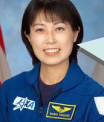JAXA Astronaut Activity Report, June 2009
Last Updated: August 25, 2009
This is JAXA's Japanese astronaut primary activity report for June 2009.
ISS Emergency Procedure Training

Astronaut Yamazaki (right) with her fellow STS-131 crew members
Astronaut Yamazaki, along with the other STS-131 crew members, participated in the International Space Station (ISS) emergency training at NASA’s Johnson Space Center (JSC) in preparation for the STS-131 mission. The training focused on emergency procedures for contingency situations aboard the ISS.
The crew learned the procedures in case of fire, rapid depressurization, or toxic spills, and reviewed where the oxygen masks and fire extinguishers are located in each of the modules. They also simulated emergency scenarios to review how to evacuate the space station following the procedures.
ISS Expedition Operations Training in Russia

Astronaut Noguchi simulating docking operations of the Soyuz TMA spacecraft(©JAXA/GCTC)
Expedition 22/23 crew member Astronaut Noguchi and his backup, Astronaut Furukawa, participated in training sessions on the Russian ISS modules and the Soyuz TMA spacecraft at the Gagarin Cosmonaut Training Center (GCTC) and RSC Energia in Russia.
Astronaut Noguchi received training on contingency procedures for ISS system operations and on how to cope with emergencies, such as a rapid depressurization inside the ISS. He also learned the life support system, water supply systems, and about the galley in the Russian service module. Training related to the Soyuz TMA spacecraft involved participating in a session on the manual rendezvous/docking maneuver using the simulator, and attending lectures on the Soyuz launch escape system.

Astronaut Furukawa reviewing the MRM-2 equipment (center)(©S.P.Korolev RSC Energia)

Astronaut Noguchi in a training session on the MRM-2 (left)(©S.P.Korolev RSC Energia)
Astronaut Furukawa participated in a training session on how to cope with rapid depressurization inside the Russian modules and another on the manual rendezvous/docking maneuver of the Soyuz TMA spacecraft.
Astronauts Noguchi and Furukawa, along with Russian cosmonauts and NASA astronauts, also attended a training session on the Mini-Research Module 2 (MRM-2). They received hands-on experience with an instructor’s briefing using the MRM-2 flight model that will actually be launched to the ISS, and became familiar with the structures and configurations of the equipment inside the MRM-2. The MRM-2 is scheduled to be launched and docked to the ISS in November 2009.
Training on EVA tools

Astronauts Timothy Creamer (left) and Noguchi (right) reviewing the storage locations of EVA tools

Reviewing and familiarizing with EVA tools
Expedition 22/23 crew member Astronaut Noguchi participated in a training session on Extravehicular Activity (EVA) tools at JSC. JAXA’s astronaut candidates Yui and Onishi also attended the training as observers. Yui and Onishi recently visited JSC in preparation for moving to Houston for their training at JSC.
The training mainly focused on handling the EVA tools that Expedition 22/23 crew members may use during EVA. The trainees reviewed the storage positions of such tools using the full-scale mockup of the Quest Airlock.
Training on Kibo-related Operations
Astronaut Furukawa participated in a training session on the Japanese Experiment Module "Kibo" and its experiment operations at the Tsukuba Space Center (TKSC).

Astronaut Furukawa during training on JEMRMS's SFA
Astronaut Furukawa received training on Kibo's robotic arm, the JEM Remote Manipulator System (JEMRMS). Using a full-scale mockup of Kibo's Pressurized Module (PM), he reviewed the difference between the JEMRMS console operations and the Backup Drive System (BDS) operations, and practiced the activation and operation of the BDS according to procedure. He also learned the operations of the Small Fine Arm (SFA), which is attached to the end of the JEMRMS.
* The BDS is the backup system hardware that enables JEMRMS operators to safely operate the JEMRMS if the JEMRMS console fails. This system is permanently deployed next to the JEMRMS console inside Kibo's PM.

Astronaut Furukawa during training to operate CBEF
Astronaut Furukawa also received training on a life science experiment that will be conducted on board Kibo, called "Life Cycle of Higher Plants under Microgravity Conditions (Space Seed)." He learned how to operate the Cell Biology Experiment Facility (CBEF) and the plant experiment units, and how to harvest plant samples. "Space Seed", led by Professor Seiichiro Kamisaka of Toyama University, the Principal Investigator (PI), aims to help us understand the effects of gravity on plants' life cycles, and to collect basic knowledge for cultivating plants in space in the future.









